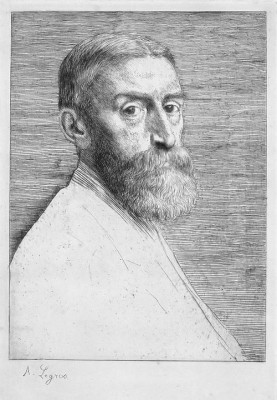
Sir Edward John Poynter stands as a significant figure in the landscape of British art during the Victorian era. Active as a painter, designer, and influential arts administrator and educator, Poynter championed the ideals of Classicism at a time when artistic tastes were beginning to diversify. His long and distinguished career saw him rise to the highest positions within the British art establishment, leaving behind a legacy of meticulously crafted works and a profound impact on institutional art education. Born into an artistic family and educated across England and the continent, Poynter's life (1836-1919) spanned a period of immense change, yet his commitment to academic principles remained a defining characteristic of his work and influence.
Early Life and Artistic Formation
Edward John Poynter was born in Paris, France, on March 20, 1836. His background was steeped in the arts; his father, Ambrose Poynter, was a noted architect and watercolourist, and his maternal grandfather was the respected sculptor Thomas Banks. This familial environment undoubtedly fostered his early inclination towards artistic pursuits. His formal education took place in England, attending institutions such as Brighton College and Ipswich School, followed by a period at Westminster School.
However, Poynter's health proved delicate during his youth. Chronic bronchial issues necessitated his withdrawal from regular schooling. Seeking milder climates, he began spending winters abroad, notably in Madeira (1852-53) and subsequently in Rome. These travels, undertaken for health reasons, proved artistically formative. It was during his winter stay in Rome in 1853-54 that he encountered Frederick Leighton, another towering figure of Victorian art who would become a lifelong friend and influence. Leighton's sophisticated Neoclassicism deeply impressed the young Poynter, steering him firmly towards the classical tradition.
Inspired and determined, Poynter formally committed to an artistic career upon his return to England. He initially studied under Thomas Shotter Boys, a watercolourist known for his topographical views, and later with Lionel William Holman. His foundational training continued at James Mathews Leigh's academy in London before he entered the Royal Academy Schools as a student in 1857, further immersing himself in the formal structures of British art education.
Parisian Studies and Continental Connections
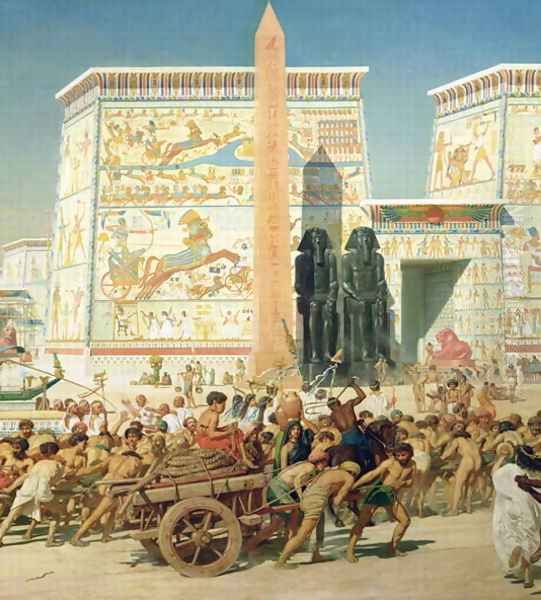
Seeking broader experience and deeper academic training, Poynter returned to Paris in 1856. He enrolled in the atelier of Charles Gleyre, a Swiss painter known for his academic approach and classical subjects, whose pupils represented a diverse range of future talents. This period was crucial for Poynter's technical development, grounding him in the rigorous drawing and compositional principles favoured by the French academic system, which looked back to masters like Jacques-Louis David and Jean-Auguste-Dominique Ingres.
In Gleyre's studio, Poynter formed significant connections with fellow students who would also achieve fame, albeit in different artistic directions. Notably, he befriended the American James McNeill Whistler and the writer and illustrator George du Maurier. While Whistler would later become a proponent of Aestheticism and challenge academic conventions, their time together in Paris fostered mutual respect and artistic exchange during their formative years. These continental experiences solidified Poynter's classical leanings while exposing him to a vibrant international artistic milieu.
Rise Through the Royal Academy
Upon returning to London, Poynter began establishing his reputation. He started exhibiting at the Royal Academy of Arts, the epicentre of the British art world. His talent and dedication to academic principles were soon recognized. In 1869, he was elected an Associate of the Royal Academy (ARA), a significant step confirming his rising status. His meticulously researched and executed historical paintings garnered considerable attention.
His full elevation to Royal Academician (RA) followed in 1876, at the age of forty. This prestigious position cemented his place within the inner circle of the British art establishment. Poynter became a consistent and prominent exhibitor at the RA's annual exhibitions, showcasing large-scale historical and mythological subjects that aligned with the institution's traditional values.
His career within the Academy culminated in his election as President of the Royal Academy (PRA) in 1896, succeeding Sir John Everett Millais. This was the highest honour attainable for a British artist, placing him at the head of the nation's foremost art institution. He held this influential post for over two decades, until his retirement in 1918. In recognition of his contributions to the arts, he was knighted by Queen Victoria in 1897, becoming Sir Edward John Poynter, and was later made a Baronet in 1902.
Artistic Style and Thematic Focus
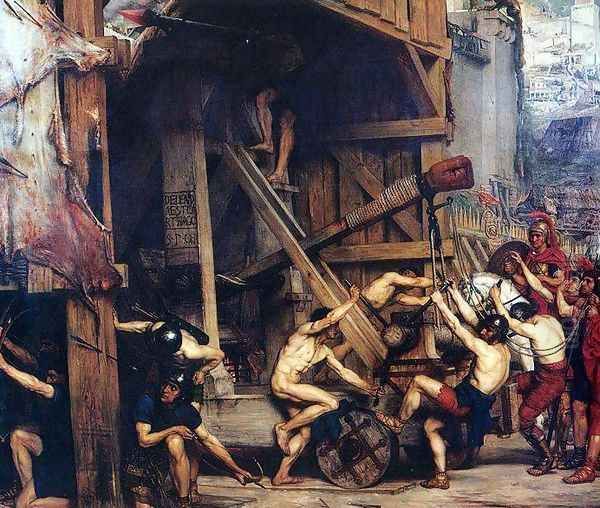
Poynter's art is synonymous with Victorian Classicism, a style that looked to the art of ancient Greece and Rome, as well as the High Renaissance, for inspiration in subject matter, composition, and the idealized depiction of the human form. He is often regarded as one of the last major exponents of this tradition in Britain, alongside contemporaries like Frederick Leighton and Lawrence Alma-Tadema. His work is characterized by meticulous draughtsmanship, complex and often crowded compositions, a smooth, highly finished surface, and a rich, sometimes jewel-like, colour palette.
Archaeological and historical accuracy were paramount in Poynter's major works. He undertook extensive research to ensure the authenticity of costumes, architecture, and artefacts depicted in his scenes from antiquity. This dedication to detail lent his paintings an air of scholarly authority, appealing to a Victorian audience fascinated by history and the classical past. His compositions often feature carefully arranged figures, demonstrating his mastery of anatomy and perspective, learned through rigorous academic training.
His primary subjects were drawn from classical mythology (such as the story of Perseus and Andromeda), biblical narratives (particularly from the Old Testament), and historical events, with a strong emphasis on ancient Egypt and Rome. He frequently depicted scenes involving large numbers of figures, showcasing his skill in managing complex narratives and creating dramatic tableaux. Alongside these grand historical pieces, Poynter also produced genre paintings, often set in classical antiquity, which focused on moments of daily life, beauty, and sentiment, as well as portraits and landscapes, particularly in watercolour.
Major Works and Critical Reception
Poynter produced several large-scale, ambitious paintings that defined his career and reputation. Among his most famous early works is Israel in Egypt (1867). Exhibited at the Royal Academy, this monumental canvas depicts the Israelites forced into labour under the Egyptians, hauling a colossal granite lion. The painting was lauded for its technical skill and dramatic scope but also sparked some debate. The buyer, engineer Sir John Hawkshaw, reportedly questioned the realism of the scene, suggesting that Poynter hadn't depicted enough slaves to realistically move such a massive statue – a comment reflecting the era's blend of artistic appreciation and practical-mindedness.
Another significant work is The Catapult (1868, reworked 1872), depicting Roman soldiers preparing a siege engine during the Siege of Carthage. This painting exemplifies Poynter's interest in historical military subjects and his ability to render complex machinery and human effort with precision. It proved popular and achieved a notable price when sold later, indicating his market appeal during his peak years.
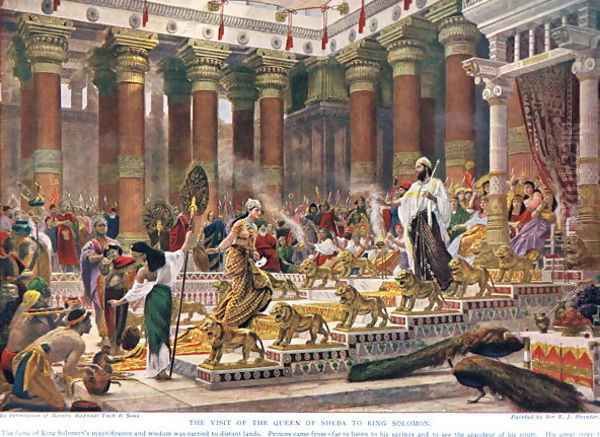
Perhaps his most elaborate painting is The Visit of the Queen of Sheba to King Solomon (1883-1890). This vast, intricate composition, now housed in the Art Gallery of New South Wales, Sydney, took years to complete and showcases Poynter's skill in marshalling hundreds of figures, luxurious details, and architectural settings into a coherent and impressive whole. It represents the apogee of his grand historical style.
Other notable works include Faithful Unto Death (1865), depicting a steadfast Roman sentry remaining at his post during the destruction of Pompeii, which became an emblem of duty and stoicism. He painted several versions of Andromeda (e.g., 1869), showcasing his skill in rendering the idealized female nude within a mythological context. Genre scenes like The Knucklebone Player and The Fortune Teller offered gentler, more intimate glimpses into imagined classical life, often highlighting female beauty and grace. Works like Pea Blossom also show his engagement with aesthetic themes.
While Poynter enjoyed considerable success and official acclaim throughout much of his career, his steadfast adherence to academic Classicism drew criticism, particularly later in life as newer art movements gained traction. His work was sometimes perceived as overly laboured, lacking in emotional depth, or resistant to the innovations of Impressionism, Post-Impressionism, and Symbolism. Critics like Roger Fry, championing Modernism, would later dismiss the highly finished academic style Poynter represented. Nevertheless, his technical brilliance and the sheer ambition of his major works were widely acknowledged.
Poynter as Educator and Administrator
Beyond his own artistic output, Poynter exerted significant influence through his roles in art education and administration. In 1871, he was appointed the first Slade Professor of Fine Art at University College London, a prestigious academic position. He held this post until 1875, helping to shape the direction of university-level art education in Britain. His lectures from this period were later published, outlining his pedagogical philosophy, which emphasized rigorous drawing and the study of the Old Masters.
From 1875 to 1881, Poynter served as Principal of the National Art Training School in South Kensington (which later evolved into the Royal College of Art). This was a key role in the government-sponsored system designed to improve standards of art and design education across the country, particularly linking art to industry. Poynter oversaw curriculum development and administration, reinforcing an academic, drawing-based approach.
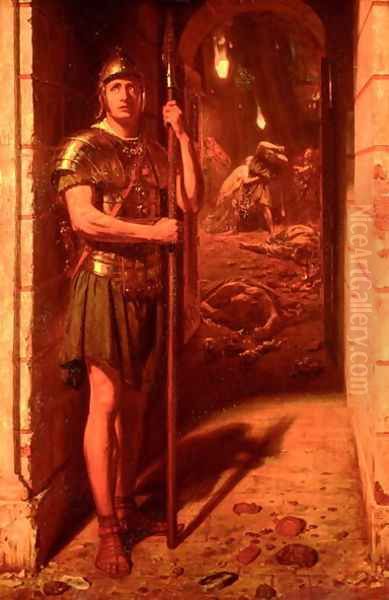
His administrative career reached another peak with his appointment as Director of the National Gallery in London, a position he held from 1894 to 1904. During his tenure, he oversaw the national collection, making acquisitions and managing the gallery's affairs. His directorship coincided with a period of significant growth and professionalization for the institution. His deep knowledge of art history and established reputation lent authority to his leadership.
His long presidency of the Royal Academy (1896-1918) placed him at the helm of the British art establishment during a turbulent period that saw increasing challenges to traditional artistic values. Poynter staunchly defended the RA's academic principles against the rise of modern art movements. He oversaw the RA Schools, the annual exhibitions, and represented the Academy's interests. His involvement in the opening of the Tate Gallery (initially the National Gallery of British Art) in 1897 also highlights his central role in the institutional art world of the time.
Wider Artistic Practice
While best known for his large oil paintings, Poynter was versatile. He was an accomplished watercolourist, often depicting landscapes and architectural subjects during his travels. His watercolour style was typically precise and controlled, characterized by careful drawing and a more restrained palette compared to his oils, capturing the tranquil beauty of English and continental scenes.
Poynter also undertook decorative work. He designed mosaics for the Central Lobby of the Palace of Westminster (Houses of Parliament) depicting St. George for England and St. David for Wales (1870s-1890s). He contributed designs for the decoration of the Grill Room at the South Kensington Museum (now the V&A). Additionally, he engaged in coin design, creating reverses for the British coinage introduced in the 1890s. These varied activities demonstrate his commitment to the integration of art and design, reflecting Victorian ideals.
Relationships and Context
Poynter operated within a rich network of artistic relationships. His early encounter with Frederick Leighton was pivotal, and their careers ran parallel courses as leading figures of Victorian Classicism. He succeeded his friend Sir John Everett Millais, a founding member of the Pre-Raphaelite Brotherhood who later adopted a broader style, as President of the Royal Academy. Poynter also maintained a friendship with Edward Burne-Jones, a leading figure of the second wave of Pre-Raphaelitism and the Aesthetic Movement, despite their differing artistic sensibilities. His early association with Whistler and Du Maurier in Paris connects him to other strands of 19th-century art.
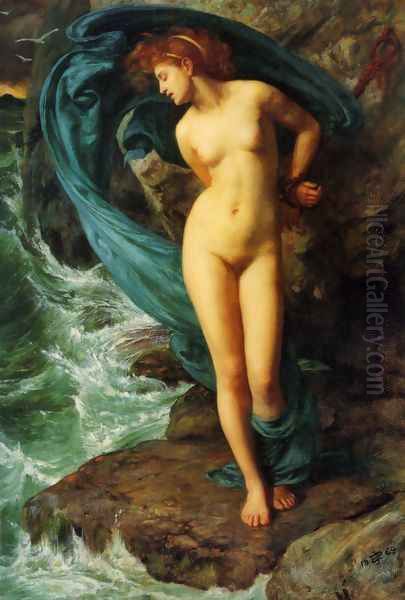
Poynter's work should be seen alongside that of other prominent Victorian academic and classical painters like Leighton, Alma-Tadema, Albert Moore, and even continental contemporaries like Jean-Léon Gérôme. These artists shared an interest in historical reconstruction, technical polish, and idealized beauty, though each had a distinct style. Poynter's particular strength lay in complex historical narratives and a certain robustness that contrasted with the more languid elegance of Moore or the domestic focus often found in Alma-Tadema's work. His career unfolded against the backdrop of competing artistic movements, from the lingering influence of Pre-Raphaelitism to the rise of Aestheticism, Impressionism, and eventually Post-Impressionism and Modernism, currents against which his traditionalism stood in increasing contrast.
Later Years and Legacy
In his later years, as artistic tastes shifted decisively towards Modernism, Poynter's influence waned, and the style he represented fell out of critical favour. The meticulous finish and historical subject matter of academic Classicism seemed increasingly irrelevant to a generation embracing new forms of expression and contemporary subject matter. While he remained President of the Royal Academy until 1918, his own artistic output slowed, and he became something of a symbol of the conservative old guard.
Despite the decline in his critical standing during the early 20th century, Poynter's contributions remain significant. He was a master technician, a painter of immense skill and learning, whose major works are impressive achievements of Victorian historical painting. His influence as an educator and administrator shaped British art institutions for decades. He played a crucial role in upholding the academic tradition and defining the public face of British art during the late Victorian and Edwardian periods.
Sir Edward John Poynter died in London on July 26, 1919, at the age of 83. As a testament to his standing within the national establishment, he was buried in St Paul's Cathedral, a final honour recognizing his long service to British art.
Conclusion
Sir Edward John Poynter's career exemplifies the trajectory of a highly successful Victorian academic artist. From his early exposure to art through his family and formative experiences in Rome and Paris, he rose through the ranks of the Royal Academy to become its President, while also holding key positions at the National Gallery and leading art schools. His paintings, characterized by meticulous research, technical precision, and a commitment to classical ideals, tackled grand historical, mythological, and biblical themes. While his style eventually faced challenges from emerging modern movements, Poynter remains a pivotal figure for understanding the art, institutions, and cultural values of late Victorian Britain. His legacy endures not only in his impressive canvases but also in the structures of art education and administration he helped to shape.